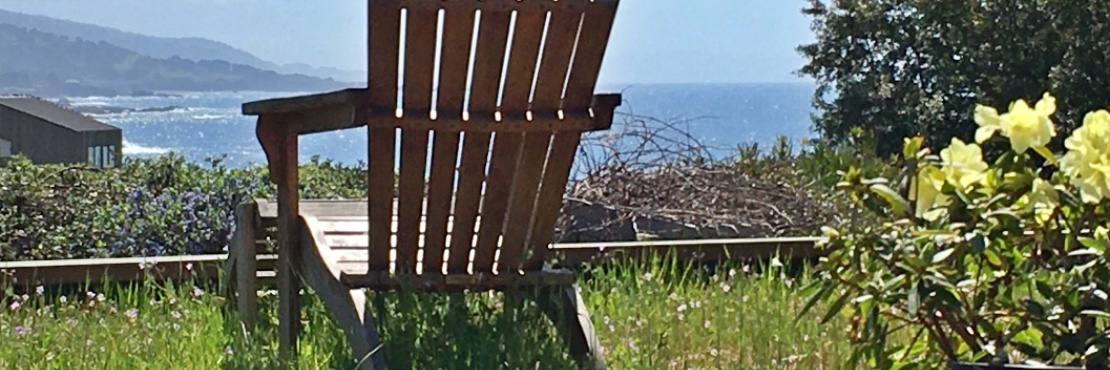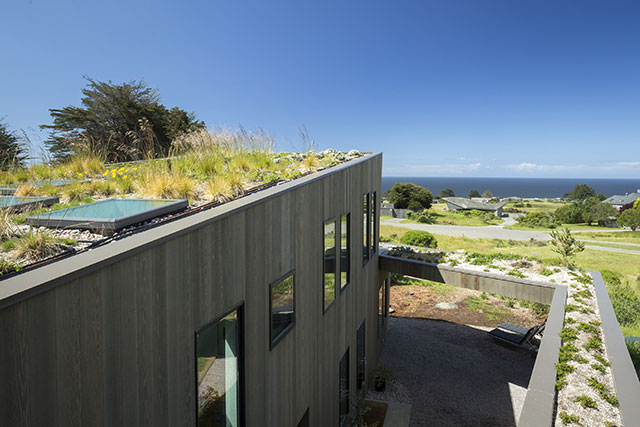This third of three articles about sod roofs (also known as green or living roofs) as a unique architectural feature at Sea Ranch, a planned community on the northern California Sonoma Coast, focuses on the threat of wildfires, insurance implications, as well as available resources.
The threat of wildfires weighs upon all of us living in California. The recent fires in Sonoma County along the coast along Highway 1, Meyers Grade Road, and the area around Lake Sonoma got awfully close to home, making us all more aware of what we need to do to protect our homes.
“With Northern California – well, actually all of California – burning up, we’ve really had to challenge ourselves to find alternatives to our traditions,” said Lisa Dundee, Director of The Sea Ranch Association’s Department of Design, Compliance, and Environmental Management, in a June 11, 2019 New York Times article entitled “Sea Ranch, California’s Modernist Utopia, Gets an Update.”
In the same article, architect Mary Griffin added, “We can’t build the way we did even 20 years ago.” Dundee and Griffin may have been speaking about alternate building materials and methodologies, but do their comments also include living roofs?
Living roofs have been part of Sea Ranch’s architectural history from the beginning. Is it now time for the value of a living roof to exceed its aesthetic value and begin to take its place as a desirable option for building for fire safety?
Living Roofs and the Risk of Wildfires
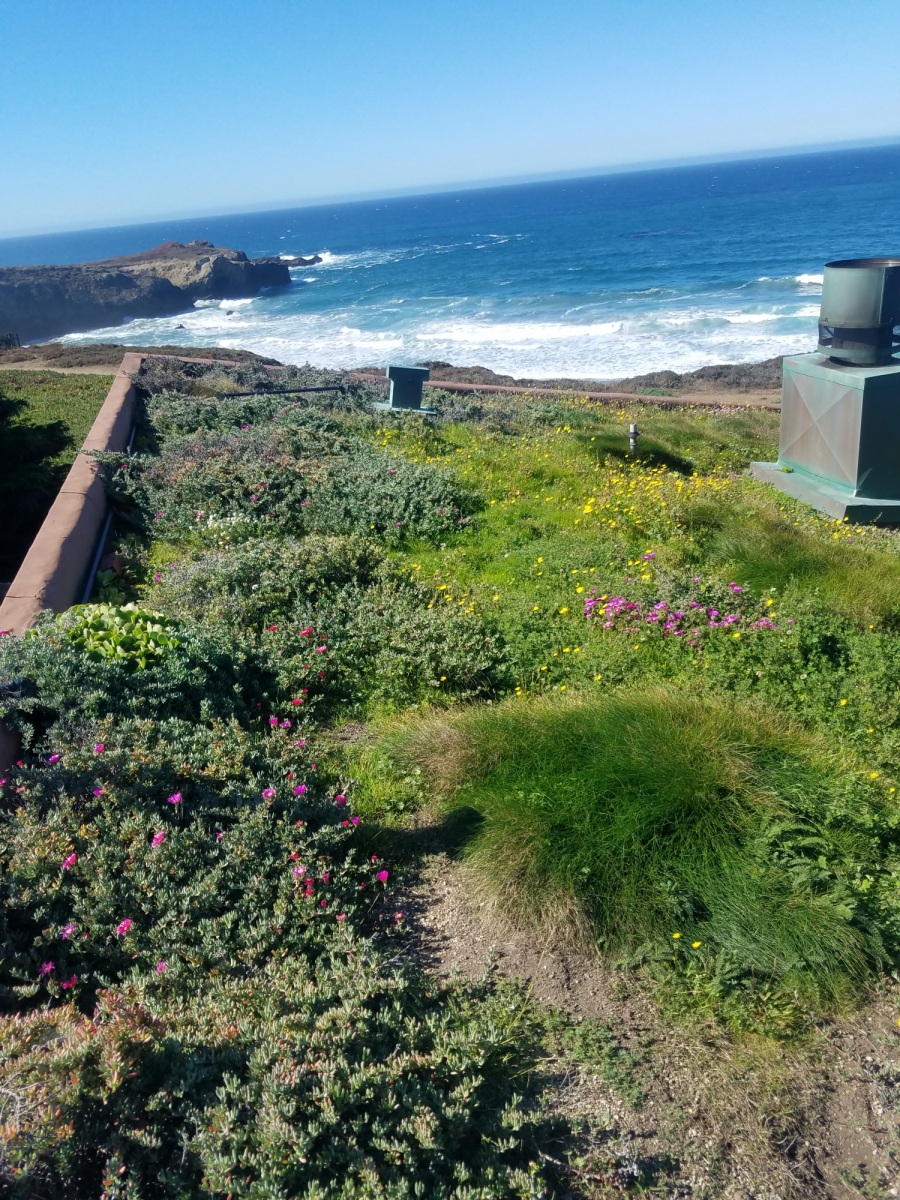
The Jones Sod Roof, overlooking the Pacific Ocean. Image: Deloras Jones.
How does a dwelling with a living roof fare in a wildfire? Although there is not much published about this issue, there is evidence that they may be a desirable alternative to standards roofs, as soil and other inorganic growing media additives (such as expanded clay and slate, etc.) do not burn.
In fact, a properly designed and well maintained living roof retains water. When wildfires spread through flying embers to a dwelling, the roof is generally the first to catch fire. If the fire can be deterred at that point, then the structure may survive. Roofs must meet a fire classification rating of one hour-called “Class A.” Living roof systems must meet the same fire requirements as standard roofing materials, but is there an opportunity to exceed this requirement with a living roof?
At the onset, a living roof should be designed by an architect, landscape architect, or related professional such as a GRP (Green Roof Professional) who understands the complexity of a properly designed greenroof system.
Importantly, fire protection should be incorporated into a green roof system. The ANSI/SPRI VF-1 2017 External Fire Design Standard for Vegetative Roofs, developed by industry organizations ANSI/SPRI along with the green roof industry association Green Roofs for Healthy Cities, include the following standards, among others:
- Media: Soil with inorganic material will not burn. Growing media must be about 80% inorganic material, which is noncombustible. Minimize organic growing media material, which can burn if it dries out.
- Watering systems: A supplemental irrigation system or direct access to a water spigot and hose will keep the roof from drying out, as any plant that dries out will burn, even succulents.
- Remove excess biomass: Fire risk is minimized by regularly removing excess biomass (dead foliage) which could become fuel (at every level, ground or rooftop).
- Plant material: Sedum and other succulents are best for drought prone areas, because they have a high water content and hold water longer.
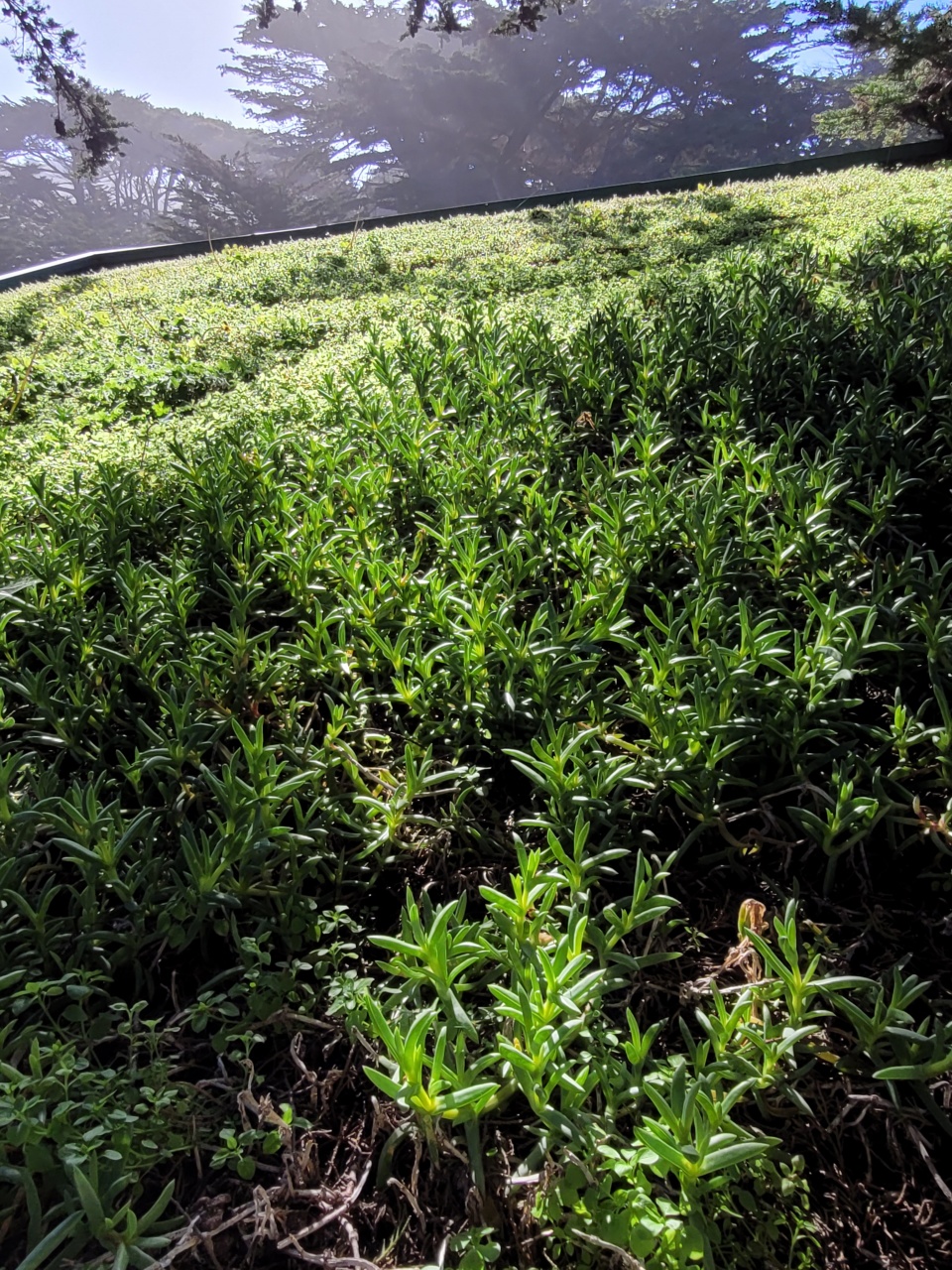
Succulents taking over a living roof, providing the best protection against burning embers in a wildfire. Image: Deloras Jones
Additional fire prevention measures are described by Redwood Miller, Captain of CALFIRE – The Sea Ranch Station:
- Maintain vegetation: Grasses on roofs need to be maintained so that they do not allow any new fires to start from embers blown in, which can then spread to other structures.
- Structure: Structural issues must be addressed during the design of your living roof. To prevent the roof’s collapse in case of an interior fire, ensure the extra weight of a living roof can be supported from burned and compromised support structures.
Captain Miller explains the importance of managing dormant and dry grasses on the roof as you would other defensible space around your house: cut them down. Otherwise, living roofs may create a fire hazard during drought conditions if not properly managed.
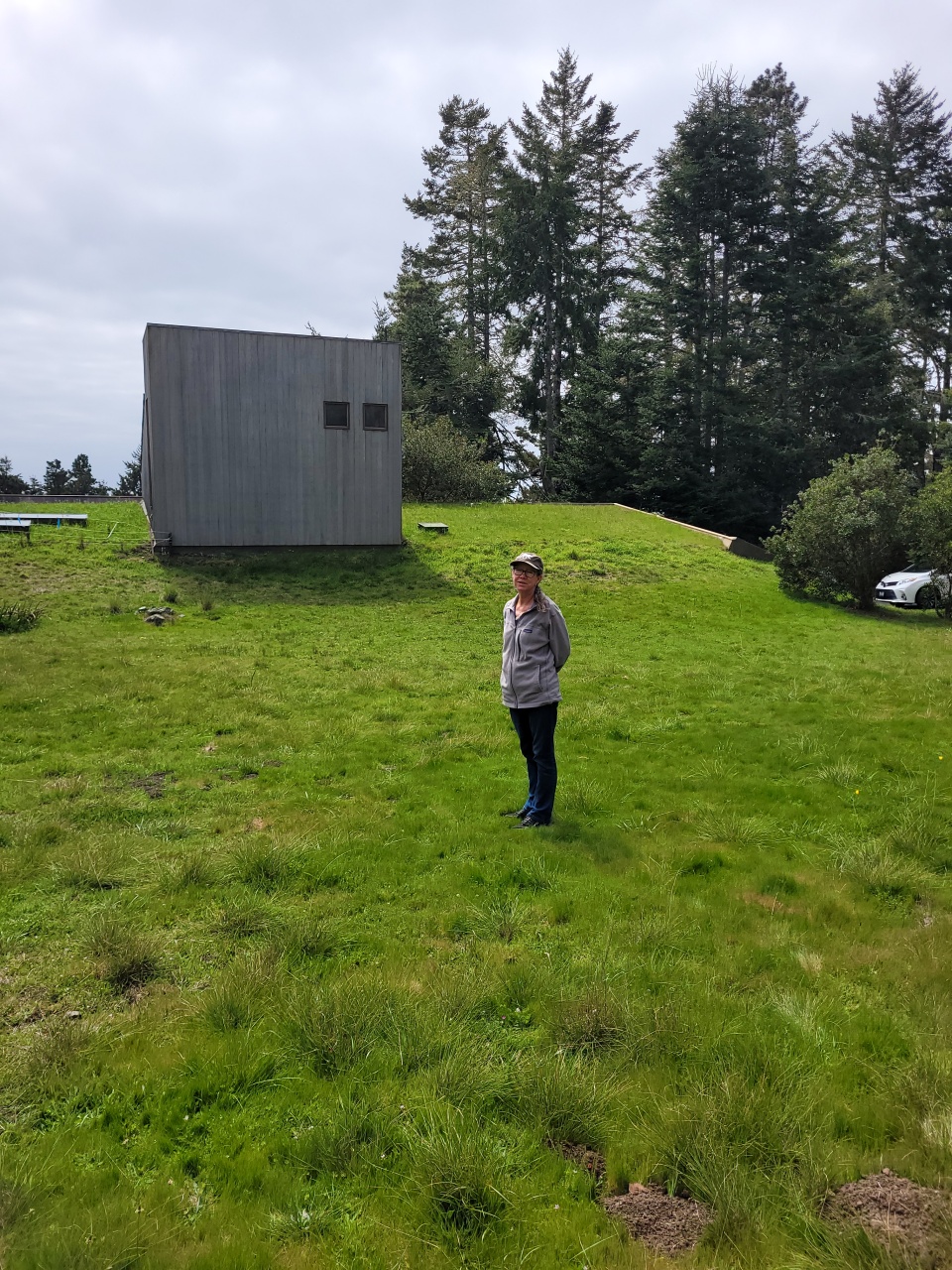
This sod roofs grows out of the meadow, making it easy to maintain dormant grass as one does defensible space around a home. Also, it provides easy access for grazing deer. The sod roof covers the entire house which is built into the side of a small hill. Image: Deloras Jones
Insurance Coverage and Fire Risk Potential
A homeowner may wonder whether their insurance will cover living roofs. Our local Gualala, California insurance agent Andrea Phillips reports that Farmers Insurance Group and as well as other companies do provide coverage for living roofs. But Phillips cautions that eligibility for a homeowner’s coverage is determined by several factors, which makes the process of insuring a home more complex.
The most important factor in determining fire coverage rates is the dwelling’s Fire Risk Score, which is based on several components, including:
- Location of the property
- Proximity to densely wooded areas
- Slope of the land surrounding the home
- Accessibility of the property for firefighters
- Presence of fire hydrants and fire stations
In addition to this key score, other factors also determine whether property insurance is available, such as whether the house is used as a vacation rental. For example, an insurance company may cover a living roof, but may or may not cover a home with a living roof that is also used as a short-term rental. Clearly, the insurance issue is not a “one size fits all” approach.
Phillips explains that there are not a lot of insurance industry guidelines available to assist agents. This, she believes, is based on the lack of knowledge and experience in underwriting single family houses with living roofs that have been exposed to wildfires. As this type of architecture becomes more prevalent and the insurance industry gains more experience with living roofs and wildfires, changes in guidelines may evolve.
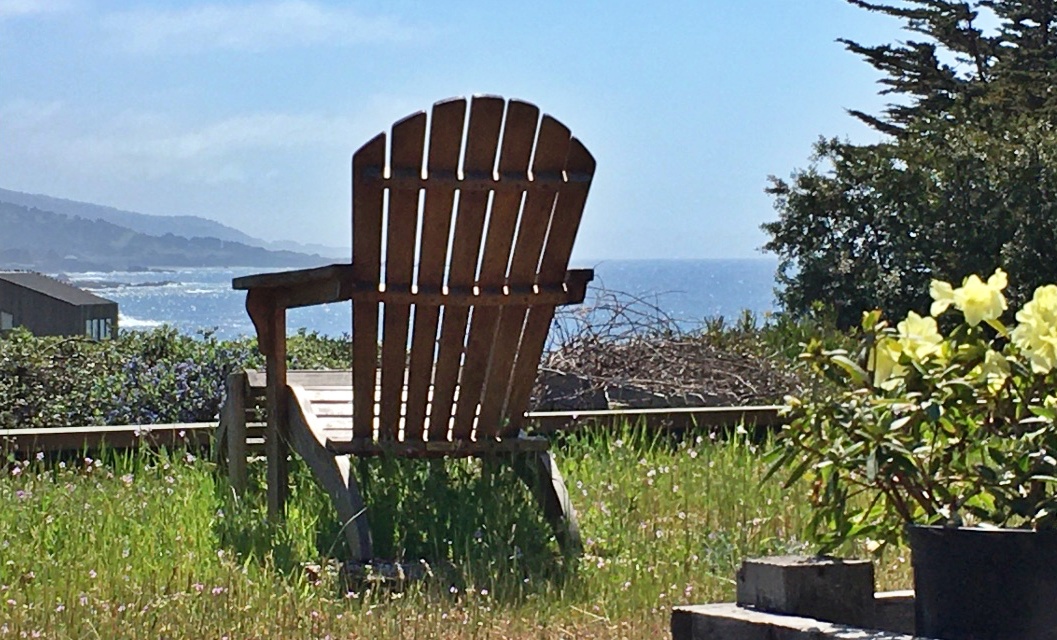
This living roof provides outdoor living space for whale watching or gardening. Image: Steve Coffey-Smith
Homeowner Experience with Living Roof
Janet MacKinnon, GRP, architect and owner of “Hedgegate,” built her Sea Ranch home in 2016, designing it as a sustainable home centered on capturing storm runoff and rainwater for irrigation. Her home goes beyond just a living roof; it has extended to “living architecture.” MacKinnon has a multi-level living roof, which even grows herbs outside the kitchen door, and a luscious living wall that complements her roof.
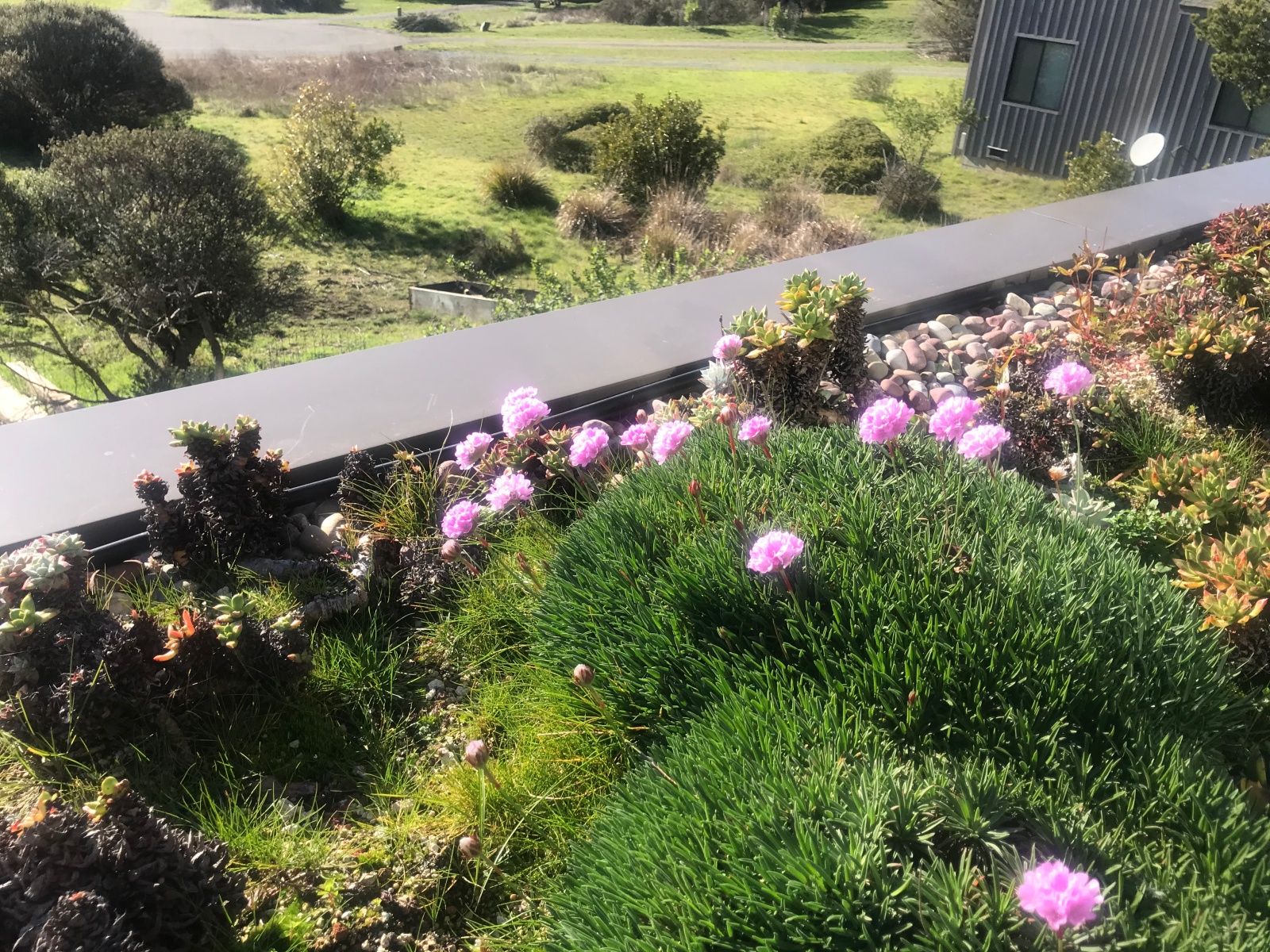
Hedgegate’s living roof with bunchgrass, succulents, dwarf manzanita, and ceanothus along with wild flowers found in nearby meadow. Image: Janet MacKinnon
Captured groundwater is stored in cisterns for irrigating the living roof. The landscaping is irrigated with collected greywater that is fed underground to each plant. The living wall system is capable of supporting vegetables, and is watered with a third system of recycled water (which will also house fish in the future). The sounds of the recycling water play with the ocean waves. This approach also assists in fire management, as the home is encompassed by a truly defensible space that does not dry out.
Living roofs, or sod roofs as our early architects called them, may increase their desirability as an architectural feature for Sea Ranchers, as we seek ways to improve protecting our dwellings from the risk of wildfires. And following the examples of MacKinnon, captured and recycled watering systems would not only water a living roof (and living wall), but also provide a valuable resource in the event of a wildfire.
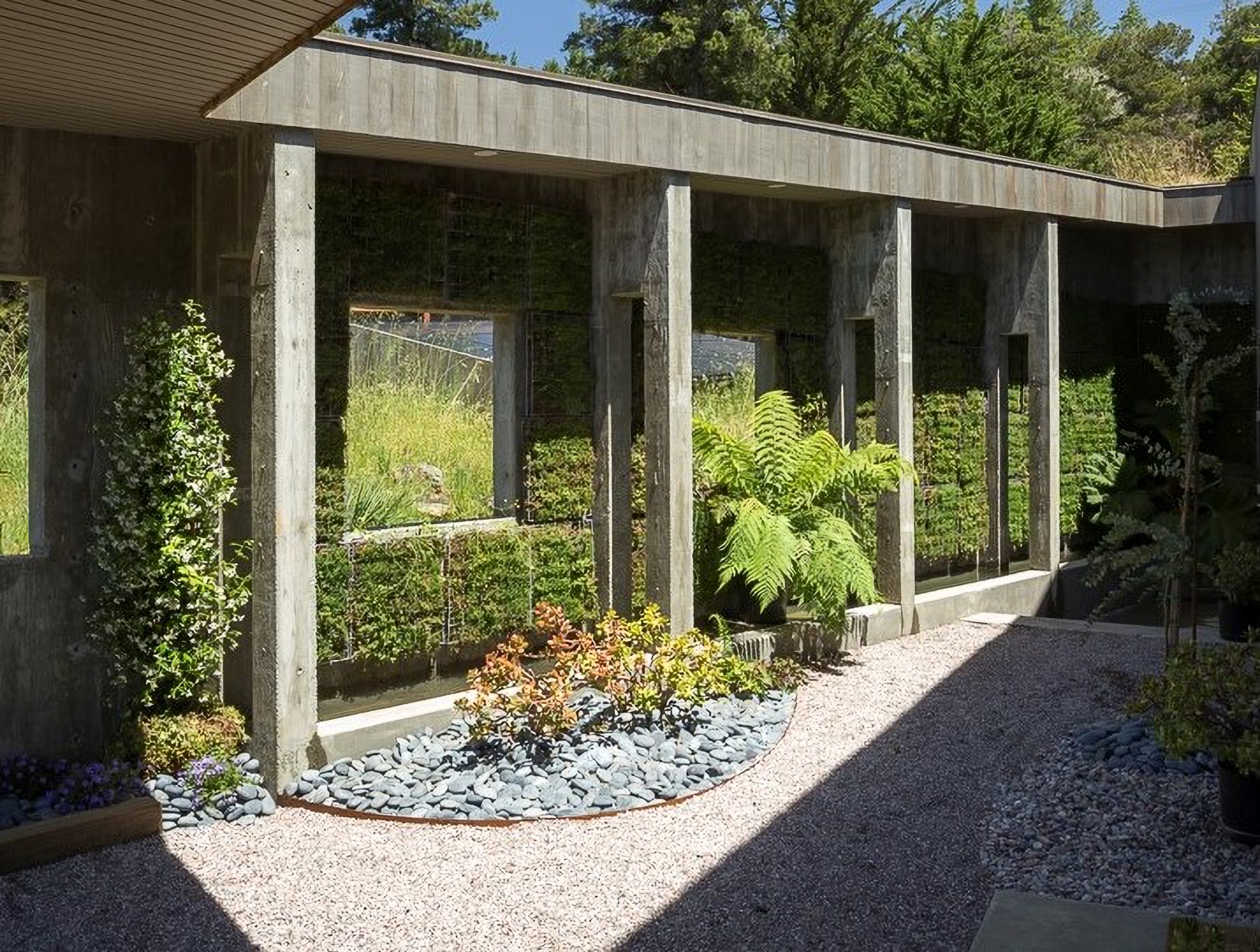
Hedgegate’s living wall provides a back drop to a restful place to relax while bring the greenspace up close. Image: Janet MacKinnon
Closing Thoughts
A properly maintained living roof incorporates fire protection into its function, while also having a cooling effect on the environment compared to an average non-vegetated heat absorbing roof.
Living roofs, or sod roofs as our early architects called them, may increase their desirability as an architectural feature for Sea Ranchers, as we seek ways to improve protecting our dwellings from the risk of wildfires. And following the examples of MacKinnon, captured and recycled watering systems would not only water a living roof but also provide a valuable resource in the event of a wildfire.
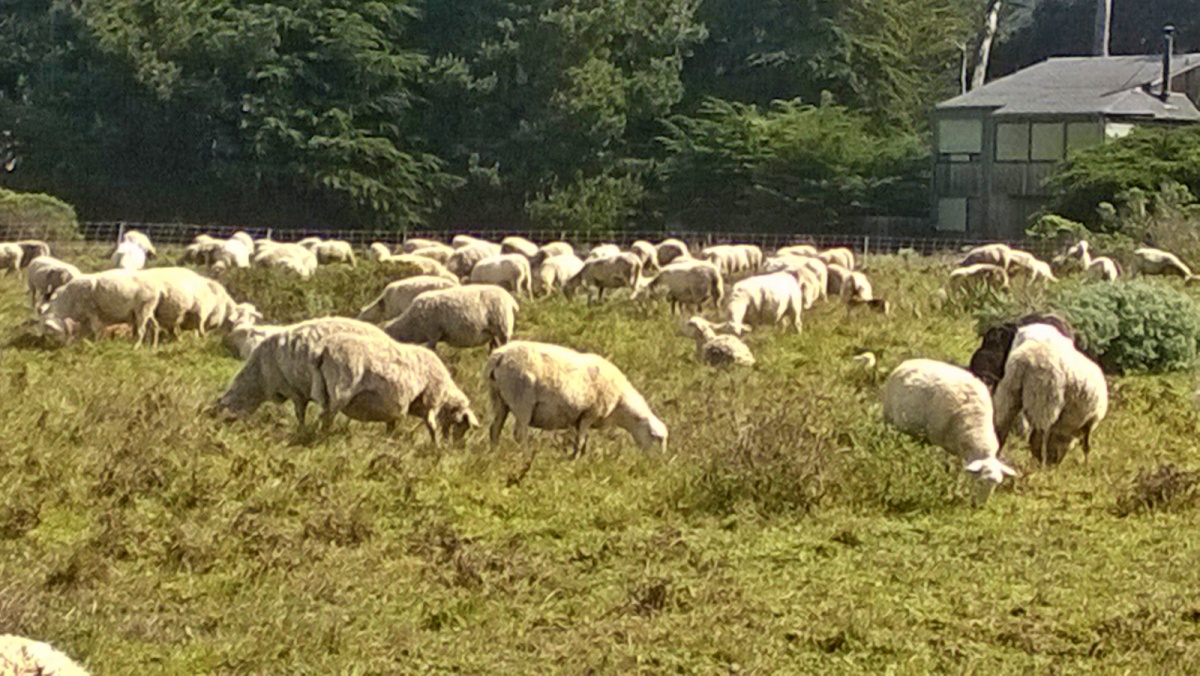
Sea Ranch sheep assist in decreasing wildfire fuel load by grazing in the meadows. Image: Deloras Jones
~ Deloras Jones, April 2021
Adapted from an article that appeared in The Sea Ranch Association’s The Bulletin, March 2021.
Publisher’s Notes:
See Deloras Jones’ Article 1: A Noble Idea: Sea Ranch’s Living Roofs and Article 2: Building and Maintenance: Sea Ranch’s Living Roofs.
Read Greenroofs.com’s FAQs for a complete rundown of commonly asked questions regarding greenroofs and greenwalls, plus Linda Velazquez’s in-depth articles: “Organic Greenroof Architecture: Sustainable Design for the New Millennium” and Organic Greenroof Architecture: Design Considerations and System Components – Growing a new roof – sustainably.
Also read more about The Sea Ranch at Journey to The Sea Ranch from The University of California Berkeley, an incredible resource.
Deloras Jones

Deloras Jones has been living at Sea Ranch since 2016 following her second retirement in health care. Previously, Deloras retired after a 37 year career with Kaiser Permanente, at which time she was the health care giant’s first system-wide nurse leader. She then went on to establish a non-profit organization that served as California’s nursing workforce center. Jones and her husband purchased their Sea Ranch home in 2001, after renting for several years. At the time of purchase all they knew about the house was that it had a great deal of deferred maintenance to be dealt with, had an incredible bluff top ocean view, and had a sod roof. To their pleasant surprise they learned they bought a historical home – one of the development’s first single family homes.
Deloras Jones is a member of Sea Ranch’s Archives Committee, and whose interest in Sea Ranch’s history was generated by living in an original and iconic home. She is also a passionate gardener who seeks to recreate the meadow on her roof – wild flowers and colorful bluff top succulents in addition to meadow grass.
Contact Deloras at: delorasjones@comcast.net
 Greenroofs.comConnecting the Planet + Living Architecture
Greenroofs.comConnecting the Planet + Living Architecture
